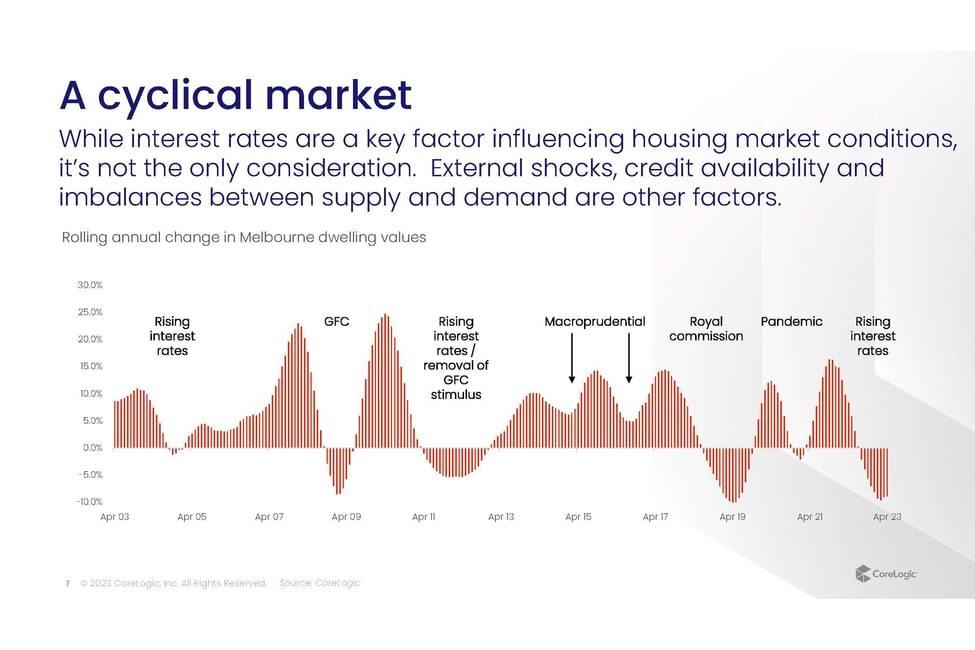Melbourne housing market perspectives and where to from here

Jellis Craig recently hosted our first Property Event, a morning of insights into the future of Melbourne’s residential real estate market, for over 450 of our clients at The Glasshouse in Melbourne.
In this article, we take a deep dive into the data-driven analysis shared by property analyst at CoreLogic, Tim Lawless.
We have just come out of a spectacular growth phase whereby we saw house values rise by nearly 30% nationally in less than 2 years – a rare (and unsustainable) amount of growth due to record low interest rates and strong demand. Following this, as interest rates rose, fiscal support was withdrawn from the marketplace, and sentiment dampened, the natural biproduct was that housing values fell – again, over a short, sharp period.
It is important to remember the cyclicality of the housing market in Australia – cycles are not always necessarily dictated by interest rates. Rather, each period of growth and decline can be influenced by a number of factors – from, in 2017 to 2019, the tightening of credit via the introduction of macroprudential policy and the banking royal commission – all of these occurred without any changes to credit rates but resulted in a downturn of values.

Of course, demographics play a significant part in housing values. Migration is absolutely rocketing right now, in part due to catch-up post border closures and part policy driven. Typically, net overseas migration flows directly and immediately into rental demand. However, a larger portion of migrants are likely to be fast tracking their purchasing decisions due to how tight rental markets are (vacancy rates at the 1% mark). At the same time, households have become smaller, amplifying demand for housing.
This rising demand has collided with low levels of available supply. In May 2023, the flow of new listings coming onto the market was tracking roughly 18% below the previous five-year average, while total stock levels were approximately 7% below average. This means that, especially at the premium end of the market, there is minimal stock for prospective buyers to choose from.
In terms of supply, we are expecting a renewed trend towards higher densities in key precincts of Melbourne over the next five years. It is likely this trend will continue upwards simply because affordability necessitates more density. Additionally town plans and government policy will aim to leverage existing infrastructure – densifying around transport nodes and key amenities makes sense from a town planning perspective. There is a good chance we will see more than half of Melbourne’s new dwelling stock characterised asmedium-high density. More emphasis on maximising dwelling space on existing areas is growing in popularity.
One of the biggest challenges with getting more supply onto the market is simply that the cost of building has risen enormously through the pandemic. Supply chain constraints, material shortages, supply shortages, labour shortages, plus the surge in building activity due to HomeBuilder all contributed to a substantial uplift in construction costs.
The rental market
Where a typically ‘healthy’ vacancy rate would be somewhere between 3-4%, in Melbourne in May 2023, the vacancy rate is hovering around 0.9% for houses and 0.7% for units. As long as vacancy rates remain low, rents will rise, in turn placing upwards pressure on renters. The solution to low vacancy rates would be either a lift in rental supply or less rental demand – both of which look challenging outcomes in the short term.
The fact is, around 80-85% of the rental housing is owned by the private sector or individuals. Although rents are rising at around the fastest pace on record, the cost of mortgage payments has risen by a substantial amount too, this means that the cost of holding a rental property has gone up more than the income from that property. This, coupled with other factors around policy, has resulted in more investors choosing to sell their properties, and fewer investors buying into the market. In turn amplifying the supply shortage of rental housing.
In order to turn around a somewhat fractured rental system, we need to see supply being delivered to the market. Looking forward, it is likely rental housing stock is in the midst of pivoting. Institutional investment is being incentivised, including the build-to-rent sector and additional funding for social and community housing among other features of the most recent Budget – which will in turn mean gradually a higher proportion of institutional investment in the rental market than what we have seen in the past.
In conclusion, whilst there are still some challenges ahead concerning economic conditions and the rapid rate hike cycle, tailwinds are becoming more evident. Inflation is reducing, interest rates are peaking, migration is high, and inventory remains extremely low. On balance, sentiment should improve, providing a lift in housing activity along with a subtle level of growth returning to housing values through the second half of the year.









